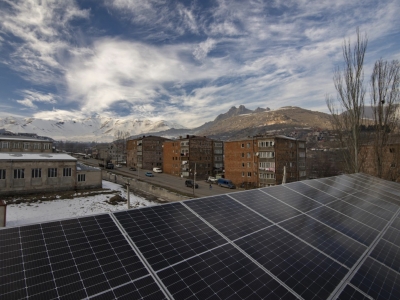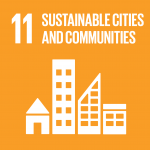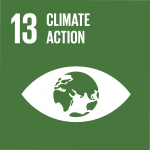The digital age of climate change adaptation

In 2012, Armenia’s annual temperature had already increased more than 1°C from 1935. The country was experiencing seasonally uneven climates, with precipitation decreasing in some regions and increasing in others, including the Lake Sevan basin. These climate trends placed Armenia’s water resources under severe threat.
In 2018, when Armenia began to develop its national plan to adapt to climate change, it faced a major barrier: fragmented data collection and climate information saved in multiple and uncoordinated locations. This inconsistency made it unreliable for conducting climate reports and analysis.
Climate data contributes to the immediate forecasts we see on the local weather channel, but it’s long term collection reveals the linear trajectory of our changing climate. Collecting data is crucial for effective climate planning, telling us how climate change has and will continue to impact different regions, sectors and communities.
The data helps inform countries on their annual mean temperatures, precipitation levels, reoccurring droughts and other climate trends. This ultimately provides the evidence needed for policymakers to develop national plans and policies that will help the country better adapt to their future climate needs.
When a country begins the process of developing a National Adaptation Plan (NAP), it requires an initial stocktaking of current barriers and vulnerable sectors. Since 2013, UNDP has supported 75 countries with their NAP process, including Armenia, and many identified the lack of cohesive data as a hurdle.
Armenia’s team developed a proposal to strengthen the national service for weather forecast and meteorological monitoring to enable timely and reliable information through secure automatic meteorological stations and a user-friendly digital database.
Certain locations of the country didn’t have sufficient number of stations to conduct historic analysis and projections of those locations. With the State Hydro-meteorological and Monitoring Service, the team surveyed all existing early-warning weather stations, mapping out the locations to ensure comprehensive coverage. The country then installed 23 automatic meteorological stations across the country.
Each station automatically stores data such as weather, daily temperatures and precipitation levels in its accumulator or ‘datalogger’. The datalogger then reports to the digital database server, where the data is processed and undergoes quality control before its archived.
Ten new automatic weather stations are on their way, funded by the Government of Japan, further supporting the modernization of high priority meteorological observing stations. The stations will be installed and synchronized with the existing data management systems.
The digital database’s automatic retrieval of climate data and real-time display has provided personnel in Armenia with reliable and necessary data in graphical formats to easily compile reports, assessments and other proposals needed in the national adaptation process.
The collected data contributed to the development of risk and vulnerability assessments of the energy, agriculture and water sectors. Assessments of the tourism and health sector are currently underway. As the five priority sectors identified in Armenia’s NAP, these assessments are an important step before developing sector-specific adaptation plans.
DIGITIZING THE PAPER RECORDS IN AZERBAIJAN
Azerbaijan was facing a similar problem with its climate, and its data collection.
In 2019, it experienced a decrease in precipitation and snow, and therefore a reduction in surface and groundwater resources, increasing drought and irrigation challenges and causing a subsequent loss of agriculture productivity.
One of the gaps identified during the development of their NAP was the limited sharing of historical data and climate statistics among institutions and ministries. Data records were previously only on paper and sharing was difficult, creating a lack of data consistency across institutions.
The NAP team first assessed the data sharing and information systems in place, then designed a web portal for cross-institutional access. Users were trained on how to use the data and information systems, as well as the new sharing protocols still being used today.
Two new automated weather stations and one mobile measurement system for water discharge will improve future data collection into their web portal. They provide real-time data on the country’s water resources and over time, this data can be analyzed for better adaptation.
BOSNIA AND HERZEGOVINA’S FIRST ENVIRONMENTAL INFORMATION SYSTEM
Since the beginning of this century in Bosnia and Herzegovina, disastrous floods and severe droughts have increased the pressure on important sectors, such as agriculture, water, housing, health, forestry, tourism, and energy. But they too also have not had a unified or central system for climate data and information.
In 2018, the country created its very first Environmental Informational System (EIS) to gather, organize and update relevant data and make it accessible to all stakeholders engaged in decision-making. . Trainings for decision makers in all levels of government explained how to use the system and create reports with the information collected. Now, the EIS allows for different ministries and institutions at the government, municipal and local level to exchange information.
For example, analyzing the climate data showed a significant increase in temperatures (up to 6°C) can be expected by the year 2100. Coupled with increased precipitation levels, greater than 20mm, flooding and periods of drought are expected to increase. With evidence of a vulnerable water sector, the country included water management as one of the seven priority sectors to focus efforts on in its NAP.
THE IMPORTANCE OF DIGITIZING DATA
With more countries starting to digitize their national climate information, solutions can now be supported by science and evidence-backed data.
These digital systems not only deliver more accurate climate trends, but they also help track and monitor if what we are doing is working or if we need to alter our next course of action. And part of solving our climate crisis, as noted in the Paris Agreement, is strengthening institutional and technical capacity to measure and report on climate impacts and risks, greenhouse gas emissions, climate change adaptation and mitigation activities.
All three countries are among those that have received funding from the Green Climate Fund Readiness Programme to develop or implement their National Adaptation Plans. Through this work, these three countries have started digitizing their national climate data and information to be better positioned to adapt and monitor their climate action.
To matter is to be counted. Only then can countries take action and create more sustainable plans to adapt to our changing environment.
***
Story by Melanie Pisano, Climate Change Communications Officer, NAPs - UNDP
Originally posted on UNDP Europe and Central Asia stories.

